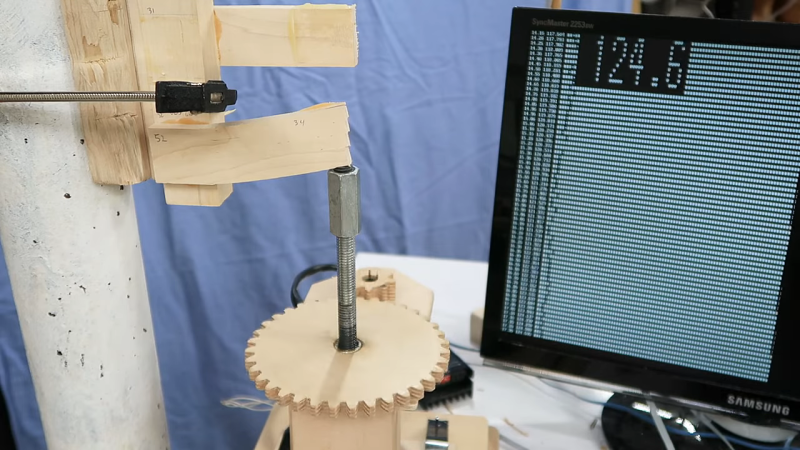Not all glues are created equal; or rather, not every glue is good for every application. But how is one to know which glue to use in which kinds of joints? The answer to that is not always clear, but solid numbers on the comparative strength of different glues are a great place to start.
To quantify what can ordinarily be a somewhat subjective process, there’s probably no one better than woodworker and hacker [Matthias Wandel], equipped as he is with his DIY strength-tester. Using its stepper-driven power to blast apart glued lap joints, [Matthias] measured the yield point of the various adhesives using a strain gauge connected to a Raspberry Pi.
His first round of tests had some interesting results, including the usually vaunted construction adhesive ending up in a distant last place. Also performing poorly, at least relative to its reputation and the mess it can cause, was the polyurethane-based Gorilla Glue. A surprise standout in overall strength was hot glue, although that seemed to have a sort of plastic yield mode. Ever the careful empiricist, [Matthias] repeated his tests using hardwoods, with remarkably different results; it seems that glues really perform better with denser wood. He also repeated a few tests to make sure every adhesive got a fair shake. Check out the video below for the final results.
It’s always good to see experiments like this that put what we often take for granted to the test. [John] over at the Project Farm channel on YouTube does this kind of stuff too, and even did a head-to-head test of epoxy adhesives.
















What about Titebond 2? Any liquid 8 hour epoxy? These are the 2 I use most. Then there is good ole’ hot hide glue which won’t win for a good reason, but I it use also.
You say won’t win for a good reason, but I understand hide glue can be a really effective somewhat flexible glue who’s real downside comes in its rather brutal assault on your olfactory senses… Sure after 100 odd years it seems to often dry out and give up, but if what you are gluing has to last that long are any of the more modern petrochemical glue actually going to prove more stable over such long terms?
Be interesting to see it tried in this style of test too.
Nice!
There’s probably a bit more to it than just pulling them apart – e.g. vibration, twisting, bending, peeling, etc, and the characteristics of the material – in which different glues will shine.
Eg Gorilla glue’s strength I believe is when your items aren’t flat and you need to fill a bit of a gap.
But using this to test e.g. brands of wood glue would be very worthwhile.
Gorilla glue’s gap filling strength is a myth. It will foam up into gaps, but that foam is extremely extremely weak. Epoxy is really the best gap filling adhesive.
While interesting, this is a very unconventional way of testing bond strength. Two very common tests to characterize adhesives are overlap shear and peel. In overlap shear, two strips, typically 1” wide samples are overlapping 1” with adhesive between them. After setting, the strips are pulled apart. This test gives highest results for fast cure epoxies and other high tensile, typically brittle adhesive (super glue too). The peel test peels a 1” strip off a flat surface. This test concentrates stress at the peal line where the strip is peeling away from the fixed surface. In these tests brittle adhesives (like fast cure epoxies and super glue) do poorly and semi flexible adhesives that can spread out the stress back into the bond do well.
Another issue is the relative flexibility of the bonding surfaces. For example, when bonding rubber to steel the adhesive should have some flexibility to spread stresses between the two surfaces.
So bond strength depends on the way the bond is used which can give very different testing requirements to characterize.
Another big factor is surface wet ability. For best results, the adhesive needs to wet the bonding surfaces. If it doesn’t, the failure will be at the surface and strength will be sub par. That can take some effort if the surfaces have differing surface tensions.
Finally, one last mention about epoxies and the difference between fast and slow cure system. In general, fast cure uses primary amines that react quickly with the epoxy end groups. The bond created are more brittle but stronger than slow cure systems. The longer cure systems use secondary and tertiary amines which have a bit more flexibility to them and thus are tougher and perform better in peel. Also, be aware that use of epoxy resins can lead to developing allergic reactions
He mentions that his test specifically simulates common carpentry joinery, meaning straight-grain to straight-grain at right angles. Plus, if he used the kind of joints he normally does when using these types of adhesives, it would break the test rig 🤣